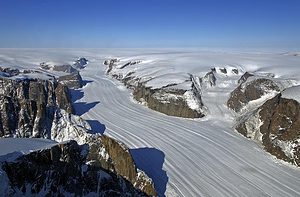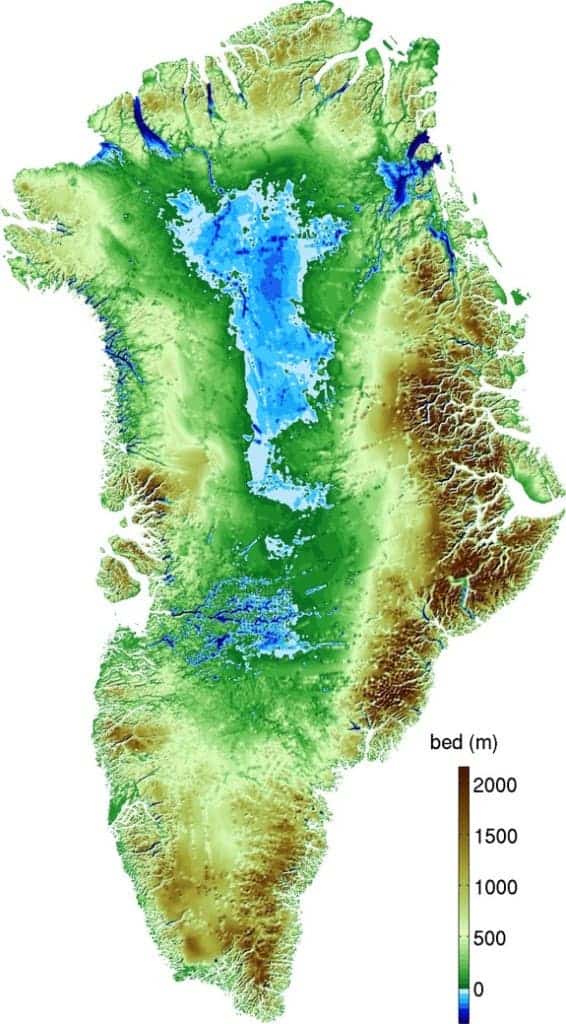News about glacial melting in Antarctica has been uniformly grim; the loss is likely unstoppable. News about melting of the Greenland Ice Sheet has been no better; Scientists had earlier believed that the losses in Greenland would eventually slow or stop, owing to the solid bedrock of the continent. Now, that view may also melt away by results of a new study that shows how the rocky topography of Greenland may actually contribute to glacier loss.
Why Greenland matters
Greenland is the world’s largest island. It’s ice sheet sits atop its rugged rock surface, often to a depth of three miles (five kilometers), and represents eight percent of the earth’s fresh water. That’s 680,000 cubic miles of frozen water which, if it all melted. would raise world sea levels by up to 18 feet (6 meters). Climate scientists pay close attention to the “health” of Greenland’s Ice Sheet (although that wasn’t always the case; back before the days of international ice patrols a Greenland glacier, Jakobshavn, is believed to have calved the iceberg that sank the Titanic).
Ice has historically been measured by ground surveys but, on a land mass that would cover over one quarter of the continental Unites States, systematic data are hard to come by. Ground-penetrating radar has been used since the 1970s to find the depth of bedrock beneath the Greenland ice but the technology doesn’t work well along the coasts because of rough surfaces and water pockets. Large portions of the island remained unexplored.
When NASA began Project IceBridge – aircraft surveys with radar – in 2009, the number of measurements tripled and a clearer picture emerged of the rough rock valleys that lay underneath the enormous glacier cover. When glaciologists from the University of California Irvine and NASA glaciologists analyzed the new data, they found previously unknown that extended for miles under the ice. And those valleys were much deeper than anyone had expected.
Different kinds of melting
Geology gives Greenland ice a different melting dynamic than that of Antarctica. Antarctic glaciers extend directly into the ocean where warm waters can melt them from below. Greenland glaciers sit on a landmass and ocean melting occurs only at the coasts.
Scientists had believed that glacier melting in Greenland would slow and stabilize after the ice moved back to where the underlying rock was higher than the sea. At that point, the land would presumably protect the ice from the surrounding ocean currents. New data changed that presumption.
“That turns out to be incorrect,” said Mathieu Morlighern, UC Irvine associate project scientist and lead author of a new study published in the May 18 issue of Nature Geoscience. “The glaciers of Greenland are likely to retreat faster and farther inland than anticipated – and or much longer – according to this very different topography we’ve discovered beneath the ice.”
What they discovered was a valley under each outlet glacier around most of Greenland’s periphery. May of those valleys are miles deep – well below sea level – and extend inland an average of 41 miles (67 kilometers). This means that as glaciers retreat, they will sink into gorges where ocean waters can follow, continuing to warm and melt the low-lying ice.
“It will take much longer for these glaciers to lose contact with the ocean,” said Morlighem. “This has major implications, because the glacier melt will contribute much more to rising seas around the globe.”
Any good news?
The scientists are no strangers to bearing bad news. The UC Irvine / NASA team involved with the new Greenland analysis are the same researchers who reported that Antarctic ice melting was “unstoppable.” Such news has the power to reignite debates about the reality and pace of climate change but not enough power to resolve coherent action.
To the extent that climate debates drift into attacks on source data and theoretical models, however, any effort to improve data quality will clarify both issues and solutions. Each contribution brings the facts into better focus.
“Operation IceBridge vastly improved our knowledge of bad topography beneath the Greenland Ice Sheet,” said Eric Rignot of UC Irvine and the NASA Jet Propulsion Laboratory. “This new study take a quantum leap in filling the remaining, critical data gaps on the map.”
The latest findings on Greenland glacier dynamics have added new factors to climate models that, unfortunately, are still pointing in the same disturbing direction.











